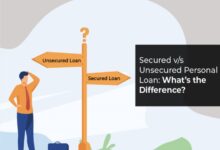Personal Loan for Bad Credit: A Comprehensive Guide
Personal loan for bad credit options can seem daunting, but understanding the landscape is key to securing the financial assistance you need. This guide navigates the complexities of securing a personal loan even with a less-than-perfect credit history, exploring eligibility criteria, loan types, reputable lenders, and crucial risk management strategies. We’ll demystify the process, empowering you to make informed decisions about your financial future.
This detailed exploration covers everything from understanding the characteristics of bad credit personal loans and their associated costs to navigating the application process and choosing a responsible lender. We’ll also examine alternative financing options and strategies for improving your credit score, providing a holistic approach to managing your finances.
Understanding Personal Loans for Bad Credit
Securing a personal loan when you have a less-than-perfect credit history can feel daunting, but it’s not impossible. Understanding the nuances of these loans is key to making informed decisions and finding the best option for your financial situation. This section will explore the characteristics, costs, and suitability of personal loans designed specifically for individuals with bad credit.
Personal loans for bad credit, often referred to as bad credit personal loans or loans for people with poor credit, are designed to provide financial assistance to individuals who have experienced credit challenges in the past. These loans typically have higher interest rates and stricter requirements compared to loans for individuals with excellent credit. However, they offer a potential pathway to rebuild credit and access needed funds.
Interest Rates and Fees for Bad Credit Personal Loans
Interest rates on personal loans for bad credit are significantly higher than those offered to borrowers with good credit. This is because lenders perceive a higher risk of default. Expect interest rates to range from 18% to 36% or even higher, depending on the lender, the loan amount, and the borrower’s specific credit profile. Additionally, fees such as origination fees (a percentage of the loan amount charged upfront) and late payment fees can significantly increase the overall cost of borrowing. It is crucial to carefully review all fees and charges before accepting a loan. For example, a $5,000 loan with a 25% interest rate and a $200 origination fee will result in substantially higher repayment costs than a similar loan with a lower interest rate and no origination fee. Always compare multiple offers to find the most favorable terms.
Comparison with Other Financing Options
Personal loans for bad credit are just one of several financing options available to individuals with poor credit. Other alternatives include secured loans (requiring collateral), payday loans (characterized by very high interest rates and short repayment periods), credit builder loans (designed to help improve credit scores), and credit cards specifically for people with bad credit. Each option carries its own set of advantages and disadvantages. Secured loans, for instance, might have lower interest rates but risk losing the collateral if you default. Payday loans, while offering quick access to funds, often trap borrowers in a cycle of debt due to their extremely high interest rates. Credit builder loans, while helping to improve credit, often involve smaller loan amounts and longer repayment periods. Credit cards for bad credit, while allowing for credit building, often come with high interest rates and low credit limits. Carefully weighing the pros and cons of each option is crucial for making an informed decision.
Situations Where a Bad Credit Personal Loan Might Be Suitable
A personal loan for bad credit can be a viable solution in specific circumstances. For example, consolidating high-interest debt (such as credit card debt) into a single, lower monthly payment can simplify financial management and potentially reduce the total interest paid over time, even with a higher initial interest rate. Another suitable scenario is covering unexpected medical expenses or emergency home repairs, where immediate access to funds is necessary. It’s important to remember that responsible borrowing and budgeting are crucial, even with a bad credit personal loan. A clear repayment plan and careful consideration of the loan’s terms are essential to avoid further financial strain. For instance, someone facing unexpected medical bills of $3,000 might find a bad credit personal loan a more manageable option than accumulating further debt on high-interest credit cards.
Eligibility Criteria and Application Process
Securing a personal loan with less-than-perfect credit can feel challenging, but understanding the lender’s perspective and the application process significantly improves your chances. This section outlines the key factors lenders consider and provides a step-by-step guide to navigate the application process successfully.
Lenders assess applications for bad credit personal loans based on a combination of factors, carefully weighing the risk involved in lending to borrowers with a history of credit challenges. The process is designed to determine the applicant’s ability and willingness to repay the loan.
Factors Influencing Loan Approval
Several key factors significantly influence the approval of a bad credit personal loan application. These factors are carefully weighed by lenders to assess the risk involved.
- Credit Score: While a lower credit score presents a higher risk, lenders still consider applications. A higher credit score, even within the “bad credit” range (generally below 670), can improve your chances of approval and secure a more favorable interest rate. For example, a score of 620 might be viewed more favorably than a score of 550.
- Income and Debt-to-Income Ratio (DTI): Lenders analyze your income to determine your ability to repay the loan. Your DTI ratio, calculated by dividing your monthly debt payments by your gross monthly income, is crucial. A lower DTI indicates a greater capacity to manage additional debt. For instance, a DTI of 30% is generally considered manageable, while a DTI of 50% might raise concerns.
- Employment History: A stable employment history demonstrates consistent income and reduces the risk of default. Lenders often prefer applicants with a proven track record of employment, especially in the same field.
- Existing Debt: The amount of existing debt and its management reflects your financial responsibility. High levels of existing debt can negatively impact your chances of approval, as it indicates a higher risk of default.
- Loan Amount and Term: The loan amount requested and the repayment term influence the lender’s assessment. Smaller loan amounts and shorter repayment terms generally pose less risk.
The Application Process: A Step-by-Step Guide
The application process for a bad credit personal loan typically involves these steps:
- Pre-qualification: Many lenders offer pre-qualification tools that allow you to check your eligibility without impacting your credit score. This provides an initial assessment of your chances of approval.
- Application Submission: Complete the online or in-person application, providing accurate information regarding your personal details, income, employment history, and debt.
- Documentation: Gather necessary documentation, such as proof of income (pay stubs, tax returns), bank statements, and identification. This verifies the information provided in your application.
- Credit Check: The lender will perform a credit check to assess your creditworthiness. This is a standard part of the loan application process.
- Loan Approval or Denial: Based on the assessment of your application and creditworthiness, the lender will either approve or deny your loan application. If approved, you’ll receive details about the loan terms, including the interest rate and repayment schedule.
- Loan Funding: Once you accept the loan terms, the funds will be disbursed to your account, typically within a few business days.
Types of Bad Credit Personal Loans
Securing a personal loan with less-than-perfect credit can feel daunting, but several options exist. Understanding the differences between loan types is crucial for making an informed decision that aligns with your financial situation and goals. This section outlines the main types of personal loans available to individuals with bad credit, highlighting their respective advantages and disadvantages.
The primary distinction lies between secured and unsecured loans. Both offer access to funds, but they differ significantly in their terms and conditions, primarily revolving around risk assessment and collateral.
Secured Personal Loans for Bad Credit
Secured personal loans require collateral – an asset you own, such as a car or savings account – to back the loan. Lenders view this collateral as a safety net, mitigating their risk in lending to borrowers with poor credit history. This often translates to more favorable interest rates and higher loan amounts compared to unsecured loans.
| Loan Type | Interest Rate | Requirements | Advantages |
|---|---|---|---|
| Secured Personal Loan (e.g., auto title loan) | Generally lower than unsecured loans, but varies based on lender and collateral value. Expect rates to be higher than those offered to borrowers with good credit. | Collateral (e.g., car, savings account), proof of income, identification. | Lower interest rates compared to unsecured loans; higher loan amounts possible; easier approval for those with bad credit. |
Unsecured Personal Loans for Bad Credit
Unsecured personal loans don’t require collateral. The lender assesses your creditworthiness based solely on your credit score, income, and debt-to-income ratio. While approval is less certain with bad credit, several lenders specialize in offering these loans, albeit typically with higher interest rates and stricter requirements.
| Loan Type | Interest Rate | Requirements | Advantages |
|---|---|---|---|
| Unsecured Personal Loan (e.g., payday loan, installment loan) | Generally higher than secured loans due to increased risk for the lender. Rates can vary widely depending on the lender and borrower’s profile. | Proof of income, identification, employment history; potentially more stringent requirements due to credit history. | No collateral required; quicker approval process in some cases (payday loans, for example); access to credit even with bad credit. |
Payday Loans and Installment Loans for Bad Credit
Payday loans are short-term, high-interest loans typically due on your next payday. Installment loans are repaid in regular installments over a longer period. Both are often considered unsecured loans and are frequently marketed to individuals with bad credit, but they come with substantial risks due to their high interest rates and potential for a debt cycle.
| Loan Type | Interest Rate | Requirements | Advantages |
|---|---|---|---|
| Payday Loan | Extremely high interest rates, often exceeding 400% APR. | Proof of income, active bank account, identification. | Quick access to funds; minimal credit check requirements. |
| Installment Loan | High interest rates compared to loans for borrowers with good credit, but generally lower than payday loans. | Proof of income, identification, employment history. | Repayment spread over multiple months, making it potentially more manageable than a payday loan. |
Finding Reputable Lenders
Securing a personal loan with bad credit requires extra diligence in choosing a lender. Navigating the lending landscape can be challenging, especially when dealing with less-than-perfect credit. Understanding how to identify legitimate lenders and avoid predatory practices is crucial for a positive borrowing experience.
Finding a reputable lender is paramount to avoid scams and high-interest rates. Many lenders cater specifically to individuals with bad credit, but not all operate ethically. Thorough research and a cautious approach are essential before committing to any loan agreement.
Identifying Legitimate Lenders
Several key indicators help distinguish legitimate lenders from fraudulent ones. Legitimate lenders will operate with transparency, providing clear and concise information about their fees, interest rates, and repayment terms upfront. They will also have a physical address and contact information readily available on their website. A lack of transparency, vague terms, or difficulty contacting the lender should raise immediate concerns. Additionally, reputable lenders will be registered and licensed to operate in your state or jurisdiction. This information is typically available through state financial regulatory agencies.
Red Flags Indicating Potential Scams
Beware of lenders who promise guaranteed approval regardless of credit history. Legitimate lenders assess creditworthiness and risk before approving loans. Similarly, be wary of lenders who request upfront fees for loan processing or application. Legitimate lenders typically only charge fees after the loan is approved. High-pressure sales tactics, aggressive communication, or requests for personal information beyond what is necessary for the loan application are also significant red flags. Finally, lenders with websites containing grammatical errors, outdated information, or suspicious domain names should be avoided.
Resources for Researching Lender Reputation
Several resources can help you research a lender’s reputation before applying for a loan. The Better Business Bureau (BBB) provides ratings and reviews for businesses, including lenders. Checking a lender’s BBB rating can reveal complaints and customer experiences. Online review platforms, such as Trustpilot and Yelp, also offer valuable insights into a lender’s reputation. Additionally, you can search for news articles or online forums discussing the lender’s practices. Finally, consulting with a financial advisor or credit counselor can provide guidance and additional resources.
Checklist for Evaluating Potential Lenders
Before committing to a loan, it’s essential to carefully evaluate the lender using a comprehensive checklist. This checklist should include verifying the lender’s licensing and registration, reviewing their interest rates and fees, understanding the repayment terms, and assessing the lender’s reputation through online reviews and resources like the BBB. Additionally, ensure the lender’s privacy policy protects your personal information and that the loan agreement is clear and concise, free from confusing or misleading language. Finally, confirm the lender’s customer service channels and their responsiveness to inquiries. A thorough review using this checklist will help you make an informed decision and avoid potential pitfalls.
Managing Debt and Improving Credit Score
Securing a personal loan with bad credit can be a stepping stone to financial recovery, but it’s crucial to understand that loan approval is only the first step. Successfully managing existing debt and actively improving your credit score are essential for long-term financial health and securing better loan terms in the future. This involves a proactive approach to debt management and consistent positive financial behavior.
Effective debt management and credit score improvement require a multifaceted strategy. It’s not a quick fix, but a process requiring consistent effort and discipline. By implementing a structured plan and utilizing available resources, you can significantly improve your financial standing over time. This will not only positively impact your credit score but also demonstrate responsible financial behavior to potential lenders, increasing your chances of securing favorable loan terms in the future.
Strategies for Debt Management
Effective debt management involves understanding your debts, creating a repayment plan, and exploring potential debt relief options. This includes prioritizing high-interest debts, exploring debt consolidation options, and budgeting effectively to ensure consistent repayments. For example, using the debt snowball or debt avalanche methods can help prioritize which debts to tackle first. The snowball method focuses on paying off the smallest debt first for motivational purposes, while the avalanche method prioritizes debts with the highest interest rates to minimize overall interest paid. Careful budgeting and tracking expenses are crucial to ensuring consistent repayments and avoiding further debt accumulation.
Step-by-Step Plan for Credit Score Improvement
Improving your creditworthiness is a journey that requires consistent effort. A structured approach can make the process more manageable.
- Obtain your credit reports: Request your credit reports from all three major credit bureaus (Equifax, Experian, and TransUnion) annually at AnnualCreditReport.com. Review them thoroughly for any inaccuracies or errors. Disputing any incorrect information is crucial for improving your score.
- Pay down existing debt: Prioritize paying down high-interest debt. Even small, consistent payments can make a difference over time. Aim to keep your credit utilization ratio (the amount of credit you’re using compared to your total available credit) below 30%. For example, if you have a $10,000 credit limit, try to keep your balance below $3,000.
- Make on-time payments: Payment history is a significant factor in your credit score. Set up automatic payments to ensure you never miss a due date. Late payments can severely damage your credit score.
- Maintain a mix of credit accounts: A diverse credit mix, such as credit cards and installment loans, can positively impact your credit score, but only if managed responsibly. Avoid opening multiple accounts simultaneously.
- Monitor your credit score regularly: Track your progress by monitoring your credit score regularly using free or paid credit monitoring services. This allows you to see the impact of your efforts and make necessary adjustments.
Impact of Responsible Financial Behavior on Future Loan Applications
Demonstrating responsible financial behavior significantly improves your chances of securing favorable loan terms in the future. Lenders view a consistently improving credit score and a history of responsible debt management as indicators of low risk. This can translate to lower interest rates, better loan terms, and increased borrowing power. For example, someone with a consistently improving credit score might qualify for a lower interest rate on a future auto loan or mortgage compared to someone with a history of late payments and high debt.
Resources and Tools for Credit Monitoring and Improvement
Several resources and tools are available to help individuals monitor and improve their credit reports and scores. These include free annual credit reports from AnnualCreditReport.com, credit monitoring services (some free, some paid), and financial counseling services offered by non-profit organizations. Utilizing these resources can provide valuable insights into your credit health and guide you toward improving your financial standing. Credit score simulators can also help you estimate the impact of different financial actions on your credit score.
Potential Risks and Alternatives
Securing a personal loan with bad credit can offer a lifeline, but it’s crucial to understand the potential downsides and explore alternative solutions before committing. High interest rates and the risk of spiraling debt are significant concerns that require careful consideration. Understanding these risks and available alternatives empowers you to make informed financial decisions.
High interest rates are a primary risk associated with bad credit personal loans. Lenders compensate for the increased risk by charging significantly higher interest rates compared to loans offered to individuals with good credit. This can lead to a substantially larger total repayment amount over the loan’s term, potentially making it difficult to manage repayments and leading to a cycle of debt. Another risk is the potential for a debt trap. If you’re already struggling financially, taking on a new loan, even for essential expenses, could exacerbate your situation if you’re unable to keep up with the monthly payments. Missed payments can further damage your credit score, creating a vicious cycle.
Comparison of Personal Loans with Alternative Financing Options
Before applying for a personal loan, consider alternatives such as credit counseling or debt consolidation. Credit counseling services can help you create a budget, negotiate with creditors, and develop a plan to manage your debt effectively. Debt consolidation involves combining multiple debts into a single loan, potentially simplifying repayment and reducing interest payments if you secure a lower interest rate. These alternatives might offer more manageable repayment terms and potentially lower overall costs.
Careful Budgeting and Financial Planning
Thorough budgeting and financial planning are paramount before considering any loan, especially one for bad credit. Creating a realistic budget allows you to assess your monthly income and expenses, ensuring you can comfortably afford the loan repayments without jeopardizing other essential needs. A well-defined financial plan should incorporate short-term and long-term goals, prioritizing debt reduction and improving your credit score. This proactive approach minimizes the risk of falling into a debt trap. For example, meticulously tracking your expenses for a month will provide a clear picture of your spending habits, allowing you to identify areas where you can cut back to free up funds for loan repayments. Similarly, setting realistic financial goals, such as paying off high-interest debt first, provides a clear roadmap for financial stability.
Pros and Cons of Personal Loans vs. Alternative Financing Solutions
| Feature | Personal Loan (Bad Credit) | Credit Counseling | Debt Consolidation |
|---|---|---|---|
| Pros | Quick access to funds; Consolidate multiple debts (in some cases); Can help with emergency expenses. | Develops a budget; Negotiates with creditors; Offers debt management plans; Free or low-cost services available. | Potentially lower interest rates; Simplifies repayments; Easier to manage a single payment. |
| Cons | High interest rates; Risk of debt trap; Can negatively impact credit score if payments are missed; May require collateral. | Requires commitment to the plan; May take time to see results; Not a quick fix solution. | May not be available to everyone; Requires good credit (for lower interest rates); May involve fees. |
Illustrative Scenarios
Understanding the potential benefits and drawbacks of personal loans for bad credit requires examining real-world examples. The following scenarios illustrate situations where such loans can be helpful and others where they can lead to further financial hardship. Careful consideration of one’s financial situation and available alternatives is crucial before taking out any loan.
Beneficial Scenario: Consolidating High-Interest Debt
Sarah, a single mother, had accumulated $10,000 in credit card debt with interest rates ranging from 18% to 24%. She was struggling to make minimum payments, and the interest was rapidly accumulating. Her credit score was low (around 550) due to past financial difficulties. She secured a personal loan for bad credit with a fixed interest rate of 12% and a manageable monthly payment plan. This allowed her to consolidate her high-interest debt into a single, lower-interest payment, significantly reducing her monthly expenses and giving her a clearer path towards debt repayment. Over time, she was able to make consistent payments, and her credit score gradually improved.
Detrimental Scenario: Unmanageable Debt Burden
Mark, a freelance graphic designer, experienced a period of low income due to a lack of projects. He took out a personal loan for bad credit to cover his living expenses, unaware of the high interest rates and fees associated with such loans. He underestimated the monthly payments, and his already strained finances were further burdened. His income remained inconsistent, making it difficult to meet the loan repayments. He fell behind on payments, leading to increased fees and penalties, further impacting his credit score and overall financial stability. The loan, intended to provide temporary relief, ultimately exacerbated his financial problems.
Wrap-Up
Securing a personal loan with bad credit requires careful planning and diligent research. By understanding the intricacies of loan types, lender selection, and risk mitigation, you can navigate the process effectively. Remember, responsible financial management and proactive credit improvement are crucial steps toward achieving long-term financial stability. This guide provides a framework for making informed choices, empowering you to take control of your financial future.





